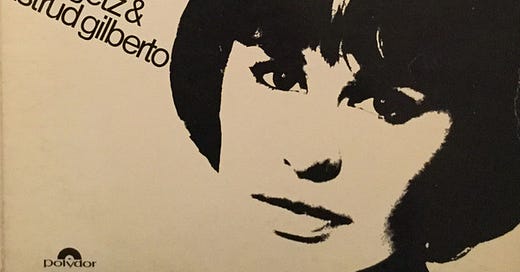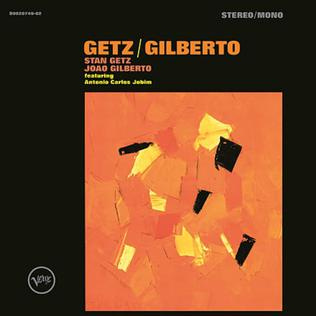“The Girl from Ipanema” by STAN GETZ, ASTRUD GILBERTO, JOAO GILBERTO, and ANTONIO CARLOS JOBIM
A song that famously evokes sunny beaches and warm breezes is darker and cooler than its easy-listening dilutions have let us believe.
She looks straight ahead
How you hear “The Girl from Ipanema” says a lot about where you’re from. American versions, ones that made the song an elevator music cliché of easy-listening kitsch, are in the key of F. Any musician in Brazil, which named the mascots for the 2016 Summer Olympics Vinicius and Tom after its songwriters, will tell you that that version of the song sounds fake.
“Fake books,” cheat sheets with rough outlines of songs that allowed musicians to fake their way through standards and show tunes, first proliferated in the 1940s. These unlicensed song books also contained traditional jazz tunes but wouldn’t be of much help for modern jazz gigs that required a working knowledge of bebop and the evolutions that followed. As a result, some enterprising students at the Berklee College of Music started assembling their own song books in the early 1970s, transcribing recorded songs and cheekily titling the unlicensed, illegal volumes The Real Book. Their version puts “Girl from Ipanema” in the key of F. Brazilian musicians all know the song should be in D♭.
“The Girl from Ipanema” became an international sensation thanks to Astrud Gilberto. She wasn’t meant to sing on the sessions her husband João and Antônio Carlos “Tom” Jobim were cutting in New York with jazz saxophonist Stan Getz, but new English lyrics had been commissioned for the song, and her command of the language was the strongest of the Brazilians in the studio. The shortened version of the song on the Getz/Gilberto album, in the key of D♭1, would be a top-5 US pop hit in 1964, introducing Bossa Nova to Stateside audiences. The song was such a sensation in Brazil that the inspiration for the song, the titular “Girl,” a 17 year-old named Helô Pinheiro, would become famous in her own right.
João Gilberto is known as the Father of Bossa Nova, which translates from Portuguese as “new trend” or “new wave.” Bossa Nova incorporated jazz and Tin Pan Alley songwriting into Samba, the Afro-Brazilian music that remains a national symbol of Brazil. This was not always a welcome development. Adulterating Samba with these American influences was initially seen as a whitewashing of this essential element of Brazilian culture, which is why changing the key of “The Girl from Ipanema” into the one in which Frank Sinatra sang “Summer Wind” rankles — it’s like the Brazilian culture from which it came has been stripped out so nothing remains but a tourist fantasy of beaches and beautiful locals.
The Portuguese lyrics to “The Girl from Ipanema” were written by Vinicius de Moraes, a poet and playwright best known for the film Black Orpheus2, which sets the story of Orpheus and Eurydice in the favelas of Rio de Janeiro during Carnival. The film won the Cannes Palme d’OR in 1959 and the Oscar for Best Foreign Film the next year. The soundtrack, written by Jobim and featuring João Gilberto, popularized their jazzier takes on Samba to American musicians like Getz. Like the original music, Moreas’s lyrics are far more complex than most English-speaking audiences would hear.
Tall, and tan, and young, and lovely
The girl from Ipanema goes walking
And when she passes he smiles, but she doesn't see
She just doesn't see, no she just doesn't see
It is indeed a song about watching a girl, but Moraes’s lyrics are laden with what he called the “gift of life in its beautiful and melancholic constant ebb and flow." It’s also a scene drawn from his own life, where he observed the 17 year-old Pinheiro passing by the Veloso bar-café on daily walks through the neighborhood, sometimes stopping in to buy cigarettes for her mother. Norman Gimble’s English lyrics do a fair job of relating a sense of longing, but smoothed-out American versions of the song miss lyrics like “Oh, why am I so alone?” that make the song not just about a pretty girl who passes by, but youth itself. Sinatra, to his credit, ends his version with Jobim on their Francis Albert Sinatra and Antonio Carlos Jobim album with “she doesn’t see… me.”
The Real Book was written for trained jazz musicians by musicians being trained to play jazz, and emphasizes the chords around which musicians would know the “good” notes to play in an improvisation. In this way, Bossa Nova isn’t any more significant than the rhythm pre-set key on an old Wurlitzer home organ; it’s reduced down into component parts — or somnambulant versions played in hotel lounges. Jobim’s subtle piano and João Gilberto’s stuttering guitar mostly eschew those chords for spare notes that draw taut the song’s emotion. Their Bossa Nova playing is in fact the jazzier way, because, to quote Miles Davis, "It's not the notes you play, it's the notes you don't play.”
Astrud Gilberto was an untrained singer, which is another reason why her vocals on a single that launched the second-most recorded3 versions of a song was pretty much an accident. What might be called her naïve vocals, however, restores some of the melancholy from Moraes’s original lyrics. She doesn’t hold onto a phrase the way a singer with honed chops might have. (Listen to Nat “King” Cole, for instance, who gives an exclamation point to each “ah.”) What she did have is a deep understanding of the meaning of the song and the lives of Cariocas. Her matter-of-fact vocals brush away the leering and exoticism from the tanned and lovely on Brazil’s beaches; it’s just a neighborhood scene. Her dispassionate near-whisper, in all its languorousness, also makes plain the truth that the U.S. version may have otherwise elided: The young beauty who passes you by is doing exactly that.
22 Song Playlist
The full version of “The Girl from Ipanema,” plus the Sinatra and Nat King Cole versions mentioned above mixed into a too-short selection of songs from both Gilbertos and Antônio Carlos Jobim.
You Can Listen to This
A slightly different version of the Best Song Ever (This Week), now in audio form.
Watch This
Adam Neely, to whom this piece owes a lot, breaks down what makes the song really interesting musically an underserving of its easy-listening purgatory. I know, it’s a half hour, but Neely makes it breeze by and guest Martina da Silva’s vocals are absolutely lovely.
Thank You
Thank you for your patience. Life, as a supportive friend once said to me, sometimes gets in the way. I will do my best to make this weekly newsletter indeed weekly going forward. Thanks so much for sharing the previous piece about “Just Like Honey.” The new subscriptions are part of what pulled me off the mat this week.
The first recording of the song by Pery Ribiero, an orchestrated affair, is in the key of G, for those of you scoring at home.
It’s a striking, beautiful film currently streaming on HBO Max.
The Beatles “Yesterday” is the most recorded song in pop history.






Obviously nobody thought to tell Jobim, Vinicius, Gilberto et all in '62 that only American Imperialists played "Garota de Ipanema" in F - https://www.youtube.com/watch?v=vbhYxhV1YrA I mean how much more un-Brazilian could you get?
And Jobim having realised his previous mistake and corrected it to the more Kosher Brazilian Db (after an abortive flirtation with G on his Peri Rebeiro arrangement) obviously only played it F a second time in '67 under duress at the hands of noted Yankee Imperialist Frank Sinatra! https://www.youtube.com/watch?v=1igMShwCKgU
Never let the truth get in the way of a good story...
God Damn Imperialists!!!
I saw Joao Gilberto at Carnegie Hall in 2000. He was, ahem, very good.